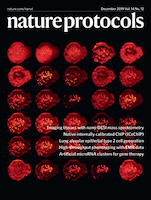
STAR Protocols
Scope & Guideline
Elevating Research Standards Through Open Access
Introduction
Aims and Scopes
- Interdisciplinary Protocols:
The journal emphasizes protocols that span multiple scientific disciplines, including molecular biology, cell biology, genetics, and bioengineering, facilitating collaboration across fields. - Methodological Rigor:
Each protocol is designed to be detailed and rigorously vetted, ensuring that it meets high standards of reproducibility and clarity for researchers looking to replicate experiments. - Focus on Novel Techniques:
STAR Protocols frequently publishes on cutting-edge methodologies, including CRISPR gene editing, advanced imaging techniques, and high-throughput screening, reflecting the latest innovations in scientific research. - Accessibility and Community Engagement:
The journal aims to make protocols accessible to a wide audience, encouraging contributions from researchers at all levels and fostering a community of practice that shares knowledge and expertise. - Robust Experimental Design:
Each protocol typically includes sections on experimental design considerations, troubleshooting tips, and optimization strategies, making them valuable resources for both novice and experienced researchers.
Trending and Emerging
- CRISPR and Gene Editing Techniques:
There is a marked increase in protocols related to CRISPR and other gene-editing technologies, highlighting the ongoing revolution in genetic manipulation and its applications in various fields. - Organoid and Stem Cell Technologies:
Protocols detailing the generation and use of organoids and stem cells are rapidly emerging, reflecting their significance in modeling diseases and testing drug responses. - High-Throughput Screening Methods:
The rise of high-throughput screening techniques, particularly in drug discovery and functional genomics, is evident, with numerous protocols focused on these methodologies. - Single-Cell Analysis Techniques:
Protocols for single-cell RNA sequencing and other single-cell analysis methods are trending, emphasizing the need for detailed insights into cellular heterogeneity and function. - Nanotechnology and Bioengineering Applications:
There is a growing focus on protocols involving nanotechnology and bioengineering applications, particularly in drug delivery systems and biosensors, indicating a shift towards integrating engineering with biological research.
Declining or Waning
- Traditional Molecular Cloning Techniques:
Protocols focusing on classical molecular cloning methods have decreased, possibly due to the rise of more efficient and versatile techniques such as CRISPR and other gene-editing technologies. - Basic Cell Culture Methods:
As advanced cell culture techniques and organoid models gain popularity, traditional protocols for basic cell culture have become less common in recent publications. - Standard Biochemical Assays:
There has been a reduction in the number of protocols detailing standard biochemical assays (e.g., ELISA, Western blotting) as researchers increasingly seek more innovative and high-throughput approaches. - Animal Models for Basic Research:
While animal models remain crucial, there is a noticeable shift towards more complex models, such as humanized mice and organoids, leading to fewer traditional animal model protocols. - General Laboratory Techniques:
Protocols that cover broad, non-specific laboratory techniques are becoming less prevalent, as the focus shifts toward specialized, innovative methodologies.
Similar Journals

FEBS Open Bio
Nurturing collaboration in the evolving landscape of biosciences.FEBS Open Bio is a leading open-access journal published by Wiley, dedicated to advancing our understanding of biochemistry, genetics, and molecular biology. Since its inception in 2011, this journal has provided a robust platform for researchers to share their findings with a wider audience, ensuring the dissemination of high-quality scientific knowledge. With an impact factor reflecting its stature in its field, FEBS Open Bio is ranked #77 out of 221 in general biochemistry, genetics, and molecular biology, placing it in the 65th percentile among its peers. This journal serves as an essential resource for professionals, researchers, and students alike, fostering collaboration and innovation within the scientific community. The commitment to open access not only enhances visibility but also promotes transparency in research, making it a vital contributor to the ongoing dialogue in biochemical and molecular biological sciences. For those looking to stay at the forefront of research developments, FEBS Open Bio is a key publication addressing the latest trends and discoveries in the field.

BRAZILIAN JOURNAL OF MEDICAL AND BIOLOGICAL RESEARCH
Championing Open Access to Scientific DiscoveryThe BRAZILIAN JOURNAL OF MEDICAL AND BIOLOGICAL RESEARCH, published by the ASSOC BRAS DIVULG CIENTIFICA, serves as a vital platform for the dissemination of cutting-edge research in the fields of medicine and biological sciences. With an ISSN of 0100-879X and E-ISSN 1414-431X, this Open Access journal has been championing free access to vital scientific knowledge since 1997. It is indexed in Scopus with notable rankings across various disciplines, including a rank of #131 in General Medicine (79th percentile) and #20 in Pharmacology, Toxicology, and Pharmaceutics (75th percentile). Covering a broad scope of topics, the journal primarily focuses on areas such as biochemistry, biophysics, immunology, neuroscience, and physiology, with a commendable categorization of Q2 and Q3 quartiles for several relevant fields in 2023. Through its commitment to high-quality research and robust peer review processes, the journal not only consolidates its reputation within the academic community but also significantly contributes to the enhancement of scientific knowledge and innovation in Brazil and beyond. Researchers, professionals, and students will find an invaluable resource in this journal, which is pivotal for those looking to stay abreast of the latest developments in medical and biological research.

eLife
Pioneering Open Access in Biological ResearcheLife is a premier open-access journal that stands at the forefront of biological and medical research, published by eLIFE SCIENCES PUBL LTD in the United Kingdom. Since its inception in 2012, the journal has made significant strides in disseminating high-quality research across various key disciplines, including Biochemistry, Genetics and Molecular Biology, Immunology and Microbiology, and Neuroscience, maintaining a prestigious Q1 quartile ranking in all these fields as of 2023. With an impressive Scopus ranking placing it among the top-tier journals—12th in General Neuroscience, 24th in General Biochemistry, and 8th in General Immunology—eLife is recognized for its impact and influence in shaping research narratives. As an open-access journal, eLife facilitates global access to groundbreaking scientific discoveries, fostering collaboration and innovation among researchers, professionals, and students alike. With a commitment to rigorous peer review and publication excellence, eLife is not just a journal; it is a vital platform contributing to the advancement of life sciences.

MOLECULAR BIOLOGY OF THE CELL
Advancing Knowledge in Cell and Molecular BiologyMOLECULAR BIOLOGY OF THE CELL is a prestigious journal published by the American Society for Cell Biology, focusing on the latest advancements in cell biology and molecular biology. Established in 1990, this journal serves as a vital forum for disseminating innovative research, methodologies, and insights that drive the understanding of cellular processes and their implications in health and disease. With a noteworthy impact factor and recognition within the top quartiles for both Cell Biology and Molecular Biology, it ranks prominently among its peers, with Scopus rankings reflecting its significance in the scientific community. Although the journal does not follow an open access model, it provides essential access options for both institutional and personal subscriptions. Researchers, professionals, and students seeking to expand their knowledge and collaborate on groundbreaking findings will find MOLECULAR BIOLOGY OF THE CELL an invaluable resource in the field.

BRITISH JOURNAL OF BIOMEDICAL SCIENCE
Cutting-edge Insights in Biochemistry and ImmunologyBRITISH JOURNAL OF BIOMEDICAL SCIENCE is a distinguished peer-reviewed journal dedicated to publishing high-quality research in the field of biomedical science. Published by FRONTIERS MEDIA SA, this journal aims to advance knowledge in essential disciplines such as biochemistry, immunology, microbiology, and infectious diseases. Since its inception in 1993, the journal has maintained a solid reputation, achieving notable rankings across multiple Scopus categories, including Q2 in Biochemistry (medical) and Q3 in Clinical Biochemistry and Infectious Diseases. With an emphasis on open access, it facilitates the widespread dissemination of scientific knowledge, ensuring that researchers, professionals, and students can access cutting-edge studies and findings essential for driving innovation in medical and clinical practices. The journal's rigorous editorial standards and commitment to scientific excellence make it an invaluable resource for anyone looking to stay at the forefront of research in biomedical sciences.

Nature Protocols
Your Gateway to Innovative Experimental ProtocolsNature Protocols, published by NATURE PORTFOLIO, is a premier academic journal specializing in the dissemination of innovative and practical experimental methodologies in the vast field of biochemistry, genetics, and molecular biology. With an impressive Scopus rank of #5 out of 221 journals and a 97th percentile status, it stands firmly in the Q1 quartile, reflecting its integral role in advancing scientific knowledge. Established in 2006, this journal provides an invaluable resource for researchers and practitioners aiming to refine their experimental techniques, ultimately driving forward the frontiers of life sciences. While currently operating under a subscription model, the journal continues to be a pivotal platform for sharing high-quality, peer-reviewed protocols that facilitate reproducibility and transparency in research. Addressing a global audience from its base in the United Kingdom, Nature Protocols is dedicated to fostering collaboration and innovation, making it indispensable for professionals and students engaged in cutting-edge scientific endeavors.

JOURNAL OF EXPERIMENTAL BIOLOGY
Elevating Biological Understanding Through Peer-Reviewed ExcellenceJOURNAL OF EXPERIMENTAL BIOLOGY, published by COMPANY BIOLOGISTS LTD, stands as a cornerstone in the fields of Animal Science, Aquatic Science, Ecology, Insect Science, and Physiology. With a rich history dating back to 1945, this esteemed journal has continually provided a platform for high-quality research, evidenced by its impressive Q1 rankings across multiple categories in the 2023 Journal Citation Reports. Located in the United Kingdom, it serves an international audience, offering critical insights and advancements in various biological sciences. As a non-open access journal, it provides rigorous peer-reviewed articles that contribute profoundly to our understanding of biological processes and their implications. With an extensive reach among researchers, practitioners, and academia, the JOURNAL OF EXPERIMENTAL BIOLOGY is not only a repository of knowledge but also a catalyst for ongoing research and innovation in experimental biology.

Bio-protocol
Connecting scientists through cutting-edge methodologies.Bio-protocol is an innovative open-access journal dedicated to the advanced fields of biochemistry, immunology, neuroscience, and plant science, published by BIO-PROTOCOL in the United States since 2023. With an E-ISSN of 2331-8325, this journal serves as a pivotal platform for sharing high-quality methodologies and experimental protocols, enabling researchers, professionals, and students to streamline their experimental workflows and enhance reproducibility in scientific research. In 2023, Bio-protocol achieved notable rankings, placing in the Q2 category for biochemistry, genetics, molecular biology, and immunology, as well as Q3 in neuroscience, reflecting its growing influence and relevance in these fields. The journal offers full open access, ensuring that cutting-edge research is freely available, promoting global collaboration and innovation in the life sciences. Engaging with Bio-protocol positions its readers at the forefront of significant scientific advancements and methodological developments.

Cells, published by MDPI in Switzerland, is a leading open-access journal that has been disseminating groundbreaking research in the fields of Biochemistry, Genetics, and Molecular Biology since its inception in 2011. With an impressive E-ISSN of 2073-4409, the journal boasts a strong impact factor and ranks in the 84th percentile for Scopus ratings, underscoring its significance in advancing scientific knowledge. As a Q1-ranked journal in both 2023 and 2020, it serves as a premier platform for researchers, professionals, and students eager to explore innovative findings and methodologies. By providing unrestricted access to high-quality research, Cells plays a pivotal role in facilitating collaboration and inspiration within the global scientific community, making it an indispensable resource for anyone interested in cutting-edge discoveries in cellular biology.

Methods and Protocols
Unlocking the potential of biochemistry and biotechnology.Methods and Protocols is a prestigious open-access journal published by MDPI, focusing on the critical domain of biochemistry, genetics, molecular biology, and biotechnology. Launched in 2018 and based in Basel, Switzerland, the journal provides a vital platform for sharing innovative methodologies and experimental protocols that advance scientific research and development. With an impressive Q2 ranking in multiple categories, including Biochemistry, Genetics and Molecular Biology, and Biotechnology, it fosters a collaborative environment for researchers and professionals to disseminate their findings. With a mission to enhance reproducibility and transparency in scientific inquiry, Methods and Protocols not only serves as an essential resource for academia but also contributes to the practical application of research in various industries. The journal's open-access model ensures that cutting-edge research is accessible to a global audience, thus promoting knowledge sharing and inspiring future innovations within the scientific community.